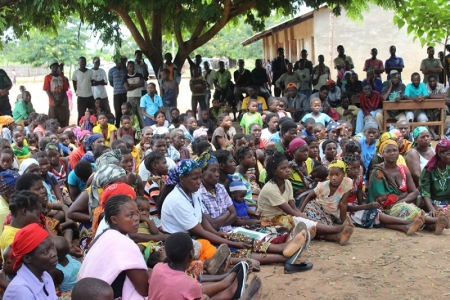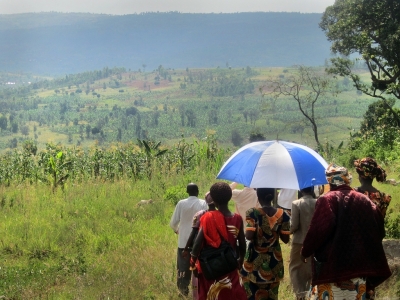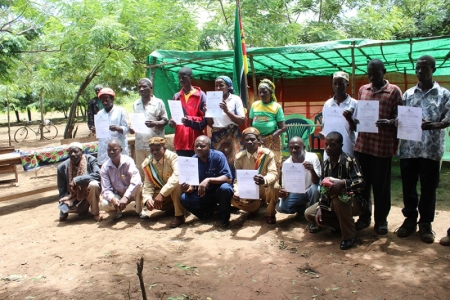Despite certain progress in recent years a large proportion of the world’s rural population, especially in low and middle-income countries, still does not have statutory recognized rights to the agricultural land and other natural resources they have been using for generations and on which they depend for their livelihoods.
They are, therefore, vulnerable to today’s escalating demand for land for large-scale commercial investments as well as to other external claims on their landed resources. Especially non-farm land, such as forest commons, which are particularly important for the livelihoods of the poor, are at risk: they are often seen by outsiders as un-used and therefore without an owner. To this could be added the importance of protecting the world’s forests as a mechanism for climate change mitigation, which, according to the recent research, is particularly effective when local communities are in control of these forests.
 A ceremony in Northern Mozambique when representatives of various communities got the formal titles to their community lands. Photo by Lasse Krantz.
A ceremony in Northern Mozambique when representatives of various communities got the formal titles to their community lands. Photo by Lasse Krantz.
Global call to action
This is the background to an initiative that The Rights and Resources Initiative (RRI), International Land Coalition (ILC), Oxfam and Helvetas Swiss Intercooperation took in 2013 by organizing an international conference in the town of Interlaken, Switzerland, with participants from the government, community and Indigenous People’s organizations, as well as the private sector and environmental organizations, to discuss how to collaborate for scaling up community land rights around the world.
This was followed by a second conference in Bern in October 2015, but now with focus on how to go “from rhetoric to action”. On this occasion there was also a presentation of the global campaign (Global Call to Action on Indigenous and Community Land Rights) launched early 2016 by these four organizations together with a large number of partners and likeminded around the world. The Global Call to Action (using the slogan and hashtag #LandRightsNow) has the goal of doubling the world’s area of formally recognized community land by 2020.
What is community lands?
First of all it should be noted that the concept “community land” includes not only forest and other non-farm commons but also individually farmed agricultural land. Hence, it is not the rights to a specific type of land or a particular land-use system for that matter, which are to be scaled up. Rather, it is a specific tenure regime, i.e., community-based tenure, where rights to own or manage land and other natural resources are secured at the level of the community as a collective landholding unit.
It is estimated that more than 50% of the world’s land area today are held under some kind of customary communal tenure system; in sub-Saharan Africa the proportion is as high as 80%. However, national governments only recognize formal, legal rights of communities to a fraction of these lands. The goal of the campaign is to increase the proportion of land under such statutory recognized community-based tenure.
 Cocamu’s joint plantation is a short walk across the hill from a newly-added coffee cleaning station. Photo by Ana Lukatela for UN Women via Flickr.
Cocamu’s joint plantation is a short walk across the hill from a newly-added coffee cleaning station. Photo by Ana Lukatela for UN Women via Flickr.
Global baseline report on land tenure
In conjunction with the Bern conference, RRI launched a groundbreaking study report: “Who Owns The World’s Land? A global baseline of formally recognized indigenous and community land rights.” The report is based on land tenure data from 64 countries around the world, constituting 82% of the global land area. Although the figures vary immensely between the countries, the study revealed that only 18% of land is formally recognized as either owned or controlled by Indigenous People and local communities. Moreover, only two countries, China and Canada, contribute almost 44% of this area. If these two countries were not included, the total percentage of land owned or controlled by Indigenous People and local communities globally would drop to 12%.
Focusing only on the countries examined in Asia, Latin America and Sub-Saharan Africa, it was found that Asia has the largest proportion of formally recognized community land (26%), but only because China contributes with so much land in this tenure category. Without China, the totals for the rest of Asia are less than 7%.
In Latin America, the area formally owned or controlled by Indigenous Peoples and local communities is distributed more evenly, with 8 out of 13 countries recognizing community-based rights to more than 10% of their land area.
Finally, in Sub-Saharan Africa the total area of statutory recognized community land is 15%. In fact, land right recognition rates exceed 10% in only 8 out of 19 countries included in the study there. It is worth pointing out that weaker forms of community control predominate in Africa more than in Asia, and much more than in Latin America, where community ownership of land is more widespread. Another typical feature of the African legal land situation is the fact that in many countries customary rights to land are recognized in statutory law but are not necessarily implemented in practice.
 A ceremony in Northern Mozambique when representatives of various communities got the formal titles to their community lands. Photo by Lasse Krantz.
A ceremony in Northern Mozambique when representatives of various communities got the formal titles to their community lands. Photo by Lasse Krantz.
Alternative to individual titling
As a strategy for securing local people’s land rights, the community-based tenure model could be seen as an alternative to the individual titling model, which has proven to be problematic when introduced in areas dominated by customary, communal tenure systems such as Sub-Saharan Africa.
Firstly, focusing on the formalization of community lands as collective holdings makes it possible to cover quite extensive areas and populations in a relatively short period of time and at a limited cost. In other words, it is a cost-effective way of providing local rural populations with some basic tenure security over their customary territories, which is especially important in today’s escalating global competition for land.
Secondly, at least in principle, this model ensures certain equality in tenure by providing community members with the same legal rights as co-holders of the community collective land holding.
Thirdly, including all types of land, e.g., individual as well as commons, agricultural as well as forest land, under one and the same tenure regime, tallies better with the integrated character of many small-holder subsistence oriented farming systems in low-income countries.
Handling community diversity and gender inequality
Formalizing land and resource rights at the level of the community also raises some difficult challenges. For instance, defining at what level of social organization and territorial basis the landholding community should be established, has in practice proven to be challenging.
Another complication is that rural communities often are not as homogeneous and internally equal as the models seem to presuppose. A case in point is women’s often weak and subordinate rights to land in customary tenure systems, which risk becoming cemented when these are given formal recognition in statutory law. A similar dilemma exists in the case of undemocratic traditional community leaders, whose power is often rooted in the control they customarily exercise over land and other natural resources.
Is it possible to combine private and community-based models?
Besides, there is a more fundamental question of whether the community-based model is only applicable in situations when the communal character of the community’s tenure system is still relatively intact. In other words, how to deal with rural communities where de facto privatization and commoditization of land relations are already quite advanced? Is individual titling then the only option? Or is it possible to design tenure systems which are capable of providing individuals and families with secure and verifiable rights to their land while also maintaining the positive aspects of the community-based system? These are some questions that in my view need to be discussed further.
Obviously, merely legally recognizing the right of local communities to their land and other resources is not sufficient. These rights must also be respected and upheld by national governments, and community´s knowledge and capacity to defend them must be strengthened. Nevertheless, it constitutes an important first step, where, as RRI’s study shows, some progress has been made, but much still remains to be done.
This blog was written by Lasse Krantz, project leader of the Land Rights Research Initiative at Gothenburg University. He has long experience of working with land tenure issues from development cooperation, policy and research. Here he reflects on the Bern land rights conference that he attended in October 2015 and on the ongoing global campaign with the goal to double the world’s area of formally recognized community land by 2020.